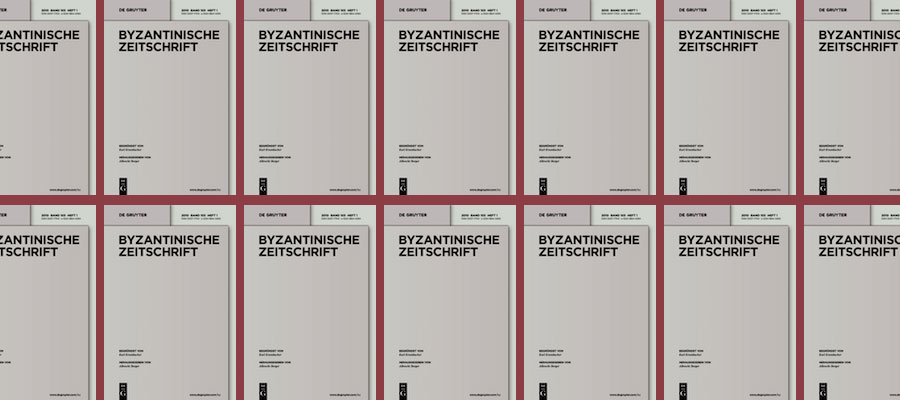Byzantinische Zeitschrift, volume 111, issue 1 (Feb 2018).
CONTENTS INCLUDE
Bessarione a lezione di astronomia da Cortasmeno
Alberto Bardi
Nel Marc. gr. Z. 333 (coll. 644), testimone del testo astronomico intitolato Παράδοσις εἰς τοὺς περσικοὺς κανόνας τῆς ἀστρονομίας (di seguito Paradosis), copiato da Bessarione, sono presenti delle aggiunte, dovute all’intervento di Bessarione stesso, che si ritrovano nella tradizione manoscritta dell’opera soltanto nei discendenti del Marc. gr. Z. 333. Tali aggiunte sono tratte da un testo astronomico di Isacco Argiro e da una versione della Paradosis riveduta da Teodoro Meliteniote. L’analisi filologica e paleografica dimostra che in entrambi i casi le aggiunte sono ricavate da un codice di Giovanni Cortasmeno. Ciò dimostra che il Bessarione ebbe Cortasmeno come maestro non solo nella filosofia aristotelica (come già era noto), ma anche nell’astronomia, e che dunque il suo interesse per questa scienza si sviluppò già nella fase poco nota della sua formazione giovanile a Costantinopoli, e non solo, come si riteneva sino ad oggi, sotto la guida di Giorgio Gemisto Pletone a Mistrà dopo il 1431.
Presence and absence of προαίρεσις in Christ and saints according to Maximus the Confessor and parallels in Neoplatonism
Grigory Benevich
The article shows that prior to the debate with the Monothelites, Maximus the Confessor followed the Christian tradition going back to Gregory of Nyssa in recognizing the presence of προαίρεσις in Christ and the saints. Later during the debate, Maximus declined to apply προαίρεσις to Christ and started to speak about the deactivation of προαίρεσις in the saints in the state of deification. Maximus was the first Orthodox author who distinguished deliberate choice (προαίρεσις) and natural will (θέλημα), and defended the presence of natural will in Christ according to His humanity. At the same time, the opposition of desire (βούλησις) and deliberate choice (προαίρεσις) can be found in some Neoplatonists, such as Iamblichus, Proclus, and Philoponus. Iamblichus and Proclus rejected the presence of προαίρεσις in the gods and god-like humans, admitting only the presence of βούλησις - the desire for the Good. Thus, the evolution of the doctrine of Maximus the Confessor, regarding the application of προαίρε- σις to Christ and the saints, finds a parallel doctrine (and even possibly a source) in Neoplatonism.
John Lydus’ knowledge of Latin and language politics in sixth-century Constantinople
Sviatoslav Dmitriev
This article contextualizes an old debate about the extent of knowledge of Latin by John Lydus, a state official and an erudite from sixth-century Constantinople, within a broader issue of the role of Latin in early Byzantium. It is argued here that Lydus’ startling etymological explanations had no relation to his level of knowledge of Latin, but reflected the declining official use of Latin in Byzantium by resurrecting the theory about Latin as a dialect of Greek.
Decoding Byzantine ekphraseis on works of art. Constantine Manasses’s description of earth and its audience
Vicky Foskolou
The study deals with ekphraseis on works of art and poses the question as to how far these texts can be a reliable source for the study or even the reconstruction of the artefacts they describe. Based on reception theory and readerresponse criticism, in the paper is proposed that as every text, byzantine ekphraseis on artworks presuppose an audience or readership, i. e. the one the author had in mind and on the basis of which he encoded his message. In order to decode this message and by extension to extract any information about the described works of art we must aim to discover their “intended reader”, and identify his or her “horizon of expectations. This proposal is tested in the study of a well known piece of this kind, Manasses’s description of a mosaic floor with a depiction of Earth. The author’s dialogue with the earlier tradition of ekphraseis, his readership’s “horizon of expectations” combined with historical facts, allow us to suppose that Manasses is describing a composition with Xenia scenes and an asarotos motif (unswept floor) created in the early byzantine period and preserved in the Great Palace of Constantinople up to the twelfth century.
Reconciling the ‘step sisters’: early Byzantine numismatics, history and archaeology
Andrei Gandila
Despite the growing body of excavation finds and the steady publication of museum collections, the numismatic evidence remains an underutilized historical source. Historians who study Late Antiquity rely on archaeological evidence but tend to ignore coin finds, partly because numismatics developed as an independent field with its own set of specialized tools and research questions. Insufficient dialogue between the disciplines has delayed a proper appreciation of Early Byzantine coins as historical source and the development of a clear methodology for their use in conjunction with the literary and archaeological evidence. In order to overcome such disciplinary divides, this paper proposes several research directions by highlighting the main benefits of integrating the numismatic evidence more fully into the historical narrative. These research directions include a greater emphasis on bronze coinage, the study of the long-distance circulation of people and goods, and distinctions between urban, rural, and fortified contexts. This methodological discussion is followed by a case study from Byzantium’s Lower Danube frontier.
“No one can escape God”. A filicidal beneficial tale from early Byzantium
Fotis Vasileiou
John Moschos includes the story of a female filicide in his Spiritual Meadow. After exploring the authorial self of Moschos, this article discusses the relation between this beneficial story and the biblical book of Jonah on the one hand, and Euripides’ Iphigenia at Aulis and Medea on the other. Finally, the story is examined in the wider framework of the seventh century, in an attempt to understand John Moschos’ viewpoint on his own time.
